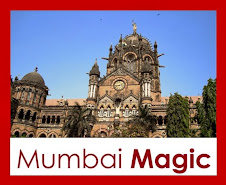- By Deepa Krishnan
Today I went with my cousin Lavanya to the India Non Fiction Festival.
I have been reading 'From Dongri to Dubai', the story of organised crime in Mumbai, so it was great to see and hear the author S Hussain Zaidi. We heard some amazing anecdotes, all the more impactful because they were couched in very no-nonsense terms.
I have been reading 'From Dongri to Dubai', the story of organised crime in Mumbai, so it was great to see and hear the author S Hussain Zaidi. We heard some amazing anecdotes, all the more impactful because they were couched in very no-nonsense terms.
Hussain Zaidi's book is very 'Bambaiya' in character. Only in Bombay would you have three underworld brothers from the Christian quarter of Byculla called the Johnny Gang, with names like Bada Johnny, Chota Johnny and Chikna Johnny :) As you may have guessed, the youngest was very good-looking.
And only in Bombay would you read an anecdote like this one: Apart from the Johnny Gang, there was a rival gang from Byculla's Muslim area. Ibrahim Dada was the leader of the gang. He once went to the passport office where he met Maria, a receptionist from the Byculla Christian locality. When he and Maria started dating, Bada Johnny confronted him. "Why are you messing around with a girl from our area?" And in reply, Ibrahim Dada actually sang a movie song: Jab Pyaar Kiya to Darna Kya! Where else except in Bombay? :)
The crimelords of Mumbai operated from several areas: Byculla, Dagdi Chawl, Chinchpokli, etc. They were Hindu as well as Muslim. All came from humble beginnings.
Here are some photos, so you get a general sense of street scenes from the Muslim areas of Byculla / Bhendi Bazaar / Dongri:
Hussain also spoke about his earlier book the Mafia Queens of Mumbai, a group of essays about some women who were an integral part of Bombay's crime scene. I think I'll buy the book. It sounds murky and fascinating, with a gritty street Bambaiya feel that I can't resist.
I also enjoyed listening to Vaibhav Purandare, author of 'Bal Thackeray - The rise and fall of the Shiv Sena'. The Sena's early years and the inter-linkages between politics, big business and trade unions were very interesting. I haven't read his book, have you?
Here is an aerial view of a section of the textile mill district in Parel. This is the setting for the Shiv Sena's meteoric rise. I clicked this photo in March 2008. Today the skyline of the area is dominated by high rise buildings.
I asked Vaibhav Purandare what he thought of the Sena's future strategy; specifically its approach towards violence. He seemed to feel there is no coherent strategy at the moment, given the factional in-fighting and split between the two cousins. He also feels that the Maharashtrian youth of today want jobs and education and to participate in the modern economy; not keep going back to a golden past or to keep throwing stones or damaging property.
Both authors served up a spicy cocktail of Mumbai's political and criminal landscape. The auditorium was completely full and there were lots of questions at the end.
And only in Bombay would you read an anecdote like this one: Apart from the Johnny Gang, there was a rival gang from Byculla's Muslim area. Ibrahim Dada was the leader of the gang. He once went to the passport office where he met Maria, a receptionist from the Byculla Christian locality. When he and Maria started dating, Bada Johnny confronted him. "Why are you messing around with a girl from our area?" And in reply, Ibrahim Dada actually sang a movie song: Jab Pyaar Kiya to Darna Kya! Where else except in Bombay? :)
The crimelords of Mumbai operated from several areas: Byculla, Dagdi Chawl, Chinchpokli, etc. They were Hindu as well as Muslim. All came from humble beginnings.
Here are some photos, so you get a general sense of street scenes from the Muslim areas of Byculla / Bhendi Bazaar / Dongri:
 |
| Muslim tenement, Byculla |
 |
| Street scene near Gol Deval |
 |
| Roof of Minara Masjid, seen from JJ flyover |
I also enjoyed listening to Vaibhav Purandare, author of 'Bal Thackeray - The rise and fall of the Shiv Sena'. The Sena's early years and the inter-linkages between politics, big business and trade unions were very interesting. I haven't read his book, have you?
Here is an aerial view of a section of the textile mill district in Parel. This is the setting for the Shiv Sena's meteoric rise. I clicked this photo in March 2008. Today the skyline of the area is dominated by high rise buildings.
 |
| Aerial view, Parel, 2008 |
Both authors served up a spicy cocktail of Mumbai's political and criminal landscape. The auditorium was completely full and there were lots of questions at the end.
Nehru Centre is always a pleasure to visit. Alongside the festival there was also an exhibition of tribal art; I bought a beautiful large Gond painting. In the photo behind us is a small part of the extensive set of Saura paintings from Orissa. The art exhibition is there tomorrow as well.











